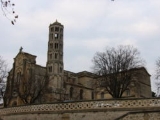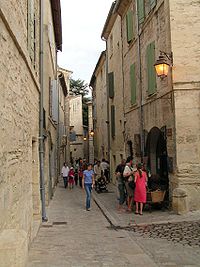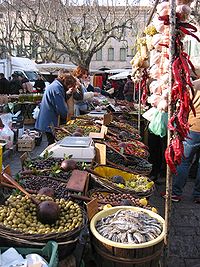
Uzès
Encyclopedia

Communes of France
The commune is the lowest level of administrative division in the French Republic. French communes are roughly equivalent to incorporated municipalities or villages in the United States or Gemeinden in Germany...
in the Gard
Gard
Gard is a département located in southern France in the Languedoc-Roussillon region.The department is named after the River Gard, although the formerly Occitan name of the River Gard, Gardon, has been replacing the traditional French name in recent decades, even among French speakers.- History...
department in southern France
France
The French Republic , The French Republic , The French Republic , (commonly known as France , is a unitary semi-presidential republic in Western Europe with several overseas territories and islands located on other continents and in the Indian, Pacific, and Atlantic oceans. Metropolitan France...
.
It lies about 25 km north-northeast of Nîmes
Nîmes
Nîmes is the capital of the Gard department in the Languedoc-Roussillon region in southern France. Nîmes has a rich history, dating back to the Roman Empire, and is a popular tourist destination.-History:...
.
History
Originally Ucetia, Uzès was a small Gallo-Roman oppidumOppidum
Oppidum is a Latin word meaning the main settlement in any administrative area of ancient Rome. The word is derived from the earlier Latin ob-pedum, "enclosed space," possibly from the Proto-Indo-European *pedóm-, "occupied space" or "footprint."Julius Caesar described the larger Celtic Iron Age...
, or administrative settlement. The town lies at the source of the Eure, from where a Roman aqueduct
Roman aqueduct
The Romans constructed numerous aqueducts to serve any large city in their empire, as well as many small towns and industrial sites. The city of Rome had the largest concentration of aqueducts, with water being supplied by eleven aqueducts constructed over a period of about 500 years...
was built in the first century BC, to supply water to the local city of Nîmes
Nîmes
Nîmes is the capital of the Gard department in the Languedoc-Roussillon region in southern France. Nîmes has a rich history, dating back to the Roman Empire, and is a popular tourist destination.-History:...
, 25KM away. The most famous stretch of the aqueduct is the Pont du Gard
Pont du Gard
The Pont du Gard is a notable ancient Roman aqueduct bridge that crosses the Gard River in southern France. It is part of a long aqueduct that runs between Uzès and Nîmes in the South of France. It is located in Vers-Pont-du-Gard near Remoulins, in the Gard département...
, which carried fresh water over splendid arches across the river Gardon
Gardon
The Gardon or Gard is a river in southern France. It is the namesake of the Gard département. Several of its tributaries are also called Gardon....
.
The civilized and tolerant urban life of 5th-century Uzès contrasted with the Frankish north. Jews
Jews
The Jews , also known as the Jewish people, are a nation and ethnoreligious group originating in the Israelites or Hebrews of the Ancient Near East. The Jewish ethnicity, nationality, and religion are strongly interrelated, as Judaism is the traditional faith of the Jewish nation...
were settled there as early as the 5th century. Saint Ferréol
Saint Ferréol of Uzès
Saint Ferréol of Uzès was bishop of Uzès and possibly bishop of Nîmes . His Feast Day is January 4....
, Bishop of Uzès, admitted them to his table and enjoyed their friendship. On this account complaint was made of him to King Childebert I
Childebert I
Childebert I was the Frankish king of Paris, a Merovingian dynast, one of the four sons of Clovis I who shared the kingdom of the Franks upon their father's death in 511...
, whereupon the bishop was obliged to change his attitude toward the Jews, compelling all those who would not become Christians to leave Uzès. After his death (581) many who had received baptism returned to Judaism.
In the 13th century, Uzès hosted a small community of Jewish scholars, as well as a community of Cathar
Cathar
Catharism was a name given to a Christian religious sect with dualistic and gnostic elements that appeared in the Languedoc region of France and other parts of Europe in the 11th century and flourished in the 12th and 13th centuries...
s.

Serge
Serge is a type of twill fabric that has diagonal lines or ridges on both sides, made with a two-up, two-down weave. The worsted variety is used in making military uniforms, suits, great coats and trench coats. Its counterpart, silk serge, is used for linings. French serge is a softer, finer variety...
s), the city and the surrounding countryside were strongly Protestant during the Wars of Religion in the 16th century, which wreaked havoc in Languedoc. Numerous of the city's churches were trashed and burned by furious Protestants: only two remain today.
The dukes of Uzès
The title of duke of Uzès, in the family de Crussol d'Uzès, is the premier title in the peerage of FrancePeerage of France
The Peerage of France was a distinction within the French nobility which appeared in the Middle Ages. It was abolished in 1789 during the French Revolution, but it reappeared in 1814 at the time of the Bourbon Restoration which followed the fall of the First French Empire...
, coming right after the princes of the blood. The title of seigneur d'Uzès is attested in a charter of 1088. After part of Languedoc was attached to royal demesne (1229), the lords' (and later dukes') military skill and fealty to the Crown propelled their rise through the nobility, until, after the treason of the last Duke of Montmorency
Montmorency
- Places :In Australia:* Montmorency, Victoria, suburb of Melbourne** Montmorency railway stationIn Canada:* Montmorency Falls, Quebec* Montmorency , Quebec* Montmorency , Quebec...
, beheaded in 1632, the title of First Duke of France fell to Uzès, who retain their stronghold in the center of town today, which has expanded round the 11th century Tour Bermond. If France were a kingdom, it would be the job of the duke of Uzès to cry out, "Le Roi est mort. Vive le Roi!" at each state funeral, and defend the honor of the queen mother. Twenty-one dukes have been wounded or killed as hereditary Champion of France over the centuries.
Sights
The present-day city retains the trace of its walls as a circuit of boulevards. A CapuchinOrder of Friars Minor Capuchin
The Order of Friars Minor Capuchin is an Order of friars in the Catholic Church, among the chief offshoots of the Franciscans. The worldwide head of the Order, called the Minister General, is currently Father Mauro Jöhri.-Origins :...
chapel, built in 1635 to house the mortal remains of the dukes, occupies the site of a 1st century AD temple dedicated to the first Roman Emperor, Augustus
Augustus
Augustus ;23 September 63 BC – 19 August AD 14) is considered the first emperor of the Roman Empire, which he ruled alone from 27 BC until his death in 14 AD.The dates of his rule are contemporary dates; Augustus lived under two calendars, the Roman Republican until 45 BC, and the Julian...
.
There are monuments of the prestige of the former bishopric, once one of the most extensive of Languedoc, but extinguished at the Revolution, and private houses that witness the wealth that the textile trade brought in the 16th century. The town is also homes to three feudal towers, the Bermonde Tower (part of the château du Duché), the Bishop Tower and the Royal Tower.
The Cathedral
Uzès Cathedral
Uzès Cathedral is a former Roman Catholic cathedral, now a parish church, in Uzès, France, dedicated to Saint Theodoritus....
was destroyed in the Albigensian Crusade
Albigensian Crusade
The Albigensian Crusade or Cathar Crusade was a 20-year military campaign initiated by the Catholic Church to eliminate Catharism in Languedoc...
, rebuilt, and destroyed again in the 16th century Wars of Religion
French Wars of Religion
The French Wars of Religion is the name given to a period of civil infighting and military operations, primarily fought between French Catholics and Protestants . The conflict involved the factional disputes between the aristocratic houses of France, such as the House of Bourbon and House of Guise...
. Rebuilt again in the 17th century, it was stripped out during the French Revolution. The 11th century Romanesque
Romanesque architecture
Romanesque architecture is an architectural style of Medieval Europe characterised by semi-circular arches. There is no consensus for the beginning date of the Romanesque architecture, with proposals ranging from the 6th to the 10th century. It developed in the 12th century into the Gothic style,...
Tour Fenestrelle ("Window Tower"), with its paired windows, is probably the most famous icon of the city.
Uzes is famous in the area for its Saturday market as not only does it sell local produce but it also sells cloths of the region as well as plenty of tourist delights.
Population
Personalities
Uzès was the birthplace of:- Firmin Abauzit (1679–1767), scholar who worked on physicsPhysicsPhysics is a natural science that involves the study of matter and its motion through spacetime, along with related concepts such as energy and force. More broadly, it is the general analysis of nature, conducted in order to understand how the universe behaves.Physics is one of the oldest academic...
, theologyTheologyTheology is the systematic and rational study of religion and its influences and of the nature of religious truths, or the learned profession acquired by completing specialized training in religious studies, usually at a university or school of divinity or seminary.-Definition:Augustine of Hippo...
and philosophyPhilosophyPhilosophy is the study of general and fundamental problems, such as those connected with existence, knowledge, values, reason, mind, and language. Philosophy is distinguished from other ways of addressing such problems by its critical, generally systematic approach and its reliance on rational... - Vice-Admiral François-Paul Brueys D'AigalliersFrançois-Paul Brueys d'AigalliersVice-Admiral François-Paul Brueys d'Aigalliers, Comte de Brueys was the French commander in the Battle of the Nile, in which the French Revolutionary Navy was defeated by Royal Navy forces under Admiral Horatio Nelson. The British victory helped to ensure their naval supremacy throughout the...
, Count de Brueys, (1753–1798), the French commander in the Battle of the NileBattle of the NileThe Battle of the Nile was a major naval battle fought between British and French fleets at Aboukir Bay on the Mediterranean coast of Egypt from 1–3 August 1798...
. - The unnamed second son of DhuodaDhuodaDhuoda was the author of the Liber Manualis, a handbook written for her son. Her date of birth and death are unknown but it is circa 803-843.-Life:...
who was famous for her medieval literature Handbook for William.
See also
- Bishopric of UzèsBishopric of UzèsThe Ancient Diocese of Uzès is a former Roman Catholic diocese in France. From the arrival of Christianity in the 5th century until the French Revolution the southern French city of Uzès was the seat of a bishop, a competitor to the local lords....
- RicqlèsRicqlèsRicqlès is a French soft drink. The brand Ricqlès was created in 1838 in Uzès, France, and was originally a medicinal mint spirit. In 1954 the company introduced the soft drink version of the beverage....
- Viscounts and Dukes of Uzès
- Philip O'ConnorPhilip O'ConnorPhilip O'Connor was a British writer and surrealist poet, who also painted. He was one of the 'Wheatsheaf writers' of 1930s Fitzrovia...
- Communes of the Gard Department

